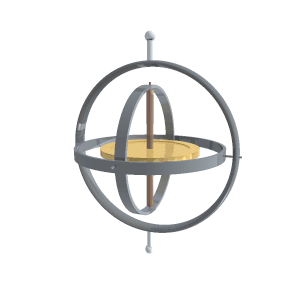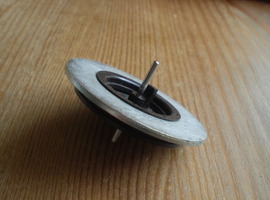Gyroscopic effect
| Polish version is here |
The gyroscopic effect is the ability of a rotating body to maintain its orientation in space due to the conservation of angular momentum. This principle, first described by Jean Foucault in 1852, is fundamental to navigation and stability systems.
An instrument that demonstrates gyroscopic effects is called a gyroscope. It consists of a disk that, once set into rapid rotational motion, maintains the original orientation of its axis of rotation. Small deviations are caused by precessional movements, which are either accounted for when determining direction or eliminated through damping.

accessed: January 20, 2012
A rotating body with limited freedom of motion of its rotational axis (for example, fixed along one of the axes of the Cartesian coordinate system) is called a top. A gyroscope is also referred to as a free top.
Gyroscopes are used to construct gyrocompasses, which have widespread applications in navigation and in devices used to indicate a selected direction in airplanes, helicopters, ships, and so on. A device built on this principle is called a gyroscope, a gyrocompass, or a gyroscopic compass. A gyroscope is also mounted in a gyrotheodolite to determine the geographic azimuth.
Fun fact: The behavior of a gyroscope directly results from the principle of conservation of angular momentum, so many rotating bodies exhibit gyroscopic properties. These include celestial bodies! Any celestial body rotating around its axis exhibits the gyroscopic effect and, consequently, precession. For Earth, the period of precession is 25,920 years.
Let’s conduct a simple experiment demonstrating the gyroscopic effect.
What Do We Need?
First, we need a gyroscope. Any well-balanced flywheel can serve this function. You can use a flywheel from a non-functioning tape recorder:
We could spin it using our muscles, but we’ll do it differently. We will mount it on the shaft of a small electric motor. We need a motor with shafts protruding from both sides. Press the gyroscope onto the shaft on one side after first removing its original axle:
Connect the motor to a power source using thin, flexible wires. Then, holding the motor in your hand, apply voltage—the gyroscope’s disk will start to spin. After reaching its maximum rotational speed, gently place the gyroscope on the shaft protruding from the opposite side. The gyroscope will not fall over, even if you give it a slight push. The motor, continuously maintaining the disk’s high speed, prevents the entire assembly from tipping over. The rotating flywheel resists any force attempting to change its orientation because altering the direction of its angular momentum vector requires torque. This resistance manifests as the gyroscopic effect, allowing the device to maintain balance even when subjected to external forces like gravity.
Note: The rotational speed of the gyroscope is typically measured in revolutions per minute (RPM). For example, if the disk spins at 5,000 RPM, this corresponds to about 523.6 radians per second. (For reference, 1 RPM ≈ 0.10472 rad/s.) If necessary, you can also convert rotational speed to imperial units: 5,000 RPM ≈ 523.6 rad/s or approximately 83.33 rotations per second.
In this experiment, the gyroscopic effect is easily observable because the angular momentum generated by the spinning disk resists changes in orientation, demonstrating the fundamental principle behind gyroscopic stability used in navigation and engineering applications.
Further readings:
- Audin M., Spinning Tops: A Course on Integrable Systems, Cambridge University Press, Nowy Jork, 1996
- Foucault L., Sur les phénomènes d’orientation des corps tournants entraînés par un axe fixe à la surface de la terre — Nouveaux signes sensibles du mouvement diurne, Comptes rendus hebdomadaires des séances de l’Académie des Sciences, 1852, vol. 35, pp. 424–427
- Klein F., Sommerfeld A., Über die Theorie des Kreisels, B.G. Teubner, Leipzig, Berlin, 1898–1914. vol. 4.
- Provatidis C.G., Revisiting the Spinning Top, International Journal of Materials and Mechanical Engineering, 2012, vol. 1, no. 4, pp. 71–88
Marek Ples

